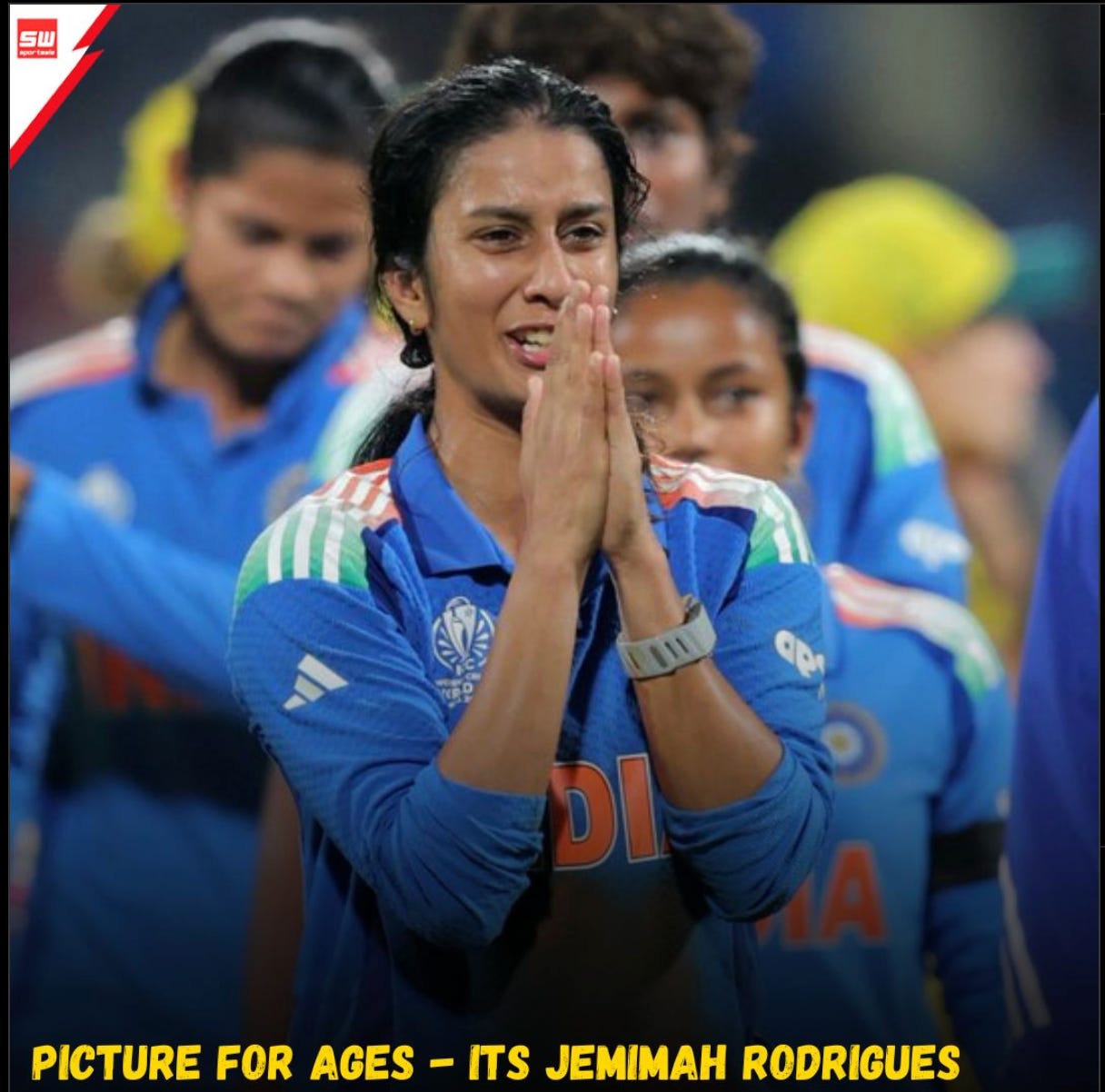In which The Indian Womens Cricket team are World Champions in 2025
🏏 Cricket’s Evolution Speaks Through Its Language and Women’s Cricket Is Its New Voice
It’s a rainy Sunday in early November of 2025.
The kind of afternoon when the city hums softly under the drizzle, tea feels earned, and doom scrolling feels inevitable. Somewhere between raindrops and notifications from the Women’s World Cup, I stop at a post about Jemimah Rodrigues.
Not for her innings, but for the caption below her image. It read;
*It’s Jemimah Rodrigues, the face of belief, courage, and dreams fulfilled!*
Beautiful words, they made me think, it’s been a while, I haven’t seen them used for a male cricketer. Men are “explosive,” “dominant,” “fearless.” Women are “elegant.” The difference may seem small, but language has always carried weight in cricket. The way we describe the game often reveals what and who we value.
From Passion to Power
In the 1990s, cricket spoke the language of *craft*. We heard commentators and read sports columns that used phrases like “solid defence,” “gritty innings,” and “building partnerships.” Newspaper columns the day after the test matches got over unfolded like sagas; poetic, slow, deliberate, and full of emphatic pauses.
By the 2000s, as the game caught pace and ODI’s took over the TV screens, the lexicon grew sharper: *“powerplay,” “strike rate,” “death overs.”* Commentary became analytical, data replaced poetry, and players turned into “finishers” and their “impact” based on the “time spent in the middle” became dominant. Then came T20 cricket’s linguistic revolution, where “Bazball,” “match-ups,” and “power-hitters” redefined excitement itself. How well a ball is hit means how high it went or how far it went. How well a ball is bowled is measured according to the speed of the ball!
The elegance of Cricket’s vocabulary evolved with its tempo: from paragraphs to sound bytes, from adjectives that defined passion to those that verbalise power.
Where the Women’s Game Fits In
In the midst of this transition, I’m riddled with the question of where the women’s game stands today. The fact is, women’s game bridges both worlds. It has the classical base of the 1980s cricket, full of class, where the geometry of the cover drive makes the fielding at silly point look like modern art. For a long time, women have been wooing Indian cricket from the stands, but now, as they take a stance on the pitch along with the athleticism, the ambition is palpating. Over the years, the sport has created a generation unafraid to take risks, yet rooted in precision who do justice to the classical definition of cricket of 80s.
Women’s cricket is about *power through skill.*”
Smriti Mandhana’s placement, Shafali Verma’s balance, Richa Ghosh’s clean hitting: every shot is measured, intelligent, intentional. The power is quieter, but no less lethal. This is the reason commentary often can’t resist falling back on “grace” and “poise.” Women can’t just *hit hard*, they also *do it beautifully.*
A Mirror of Evolution
To everyone who is now catching up to Indian women’s cricket thanks to the team reaching finals of the World Cup, the women’s game isn’t behind; it’s *in translation.* It’s walking the same evolutionary arc men’s cricket did, only faster and more self-aware.
- If the 1980s were about patience and character.
- Then the 2000s brought strategy and control.
- Now 2020s thrive on data and entertainment.
Women’s cricket today carries all three: the passion of the past, the intelligence of the middle, and the energy of the now.
The Language of the Game is elegant, but biased
From *“occupying the crease”* to *“owning the moment,”* from *“crafting an innings”* to *“clearing the ropes,”* the words we use tell the story of where the game is going. But they also tell us how we still perceive women in sport, often through the lens of aesthetics rather than authority. It’s time we recognised that the women’s game isn’t softer cricket; it’s smarter cricket. It reminds us that timing is a strength, and subtlety can still dominate and win the game. While the perception of men’s cricket has become an arms race of muscle, the women’s game is like an art school; the emphasis is on skill.
The Final Word
Cricket has always told its story through language.
And right now, the women are rewriting the script, one clean shot, one new word at a time. Today it is Champions!




